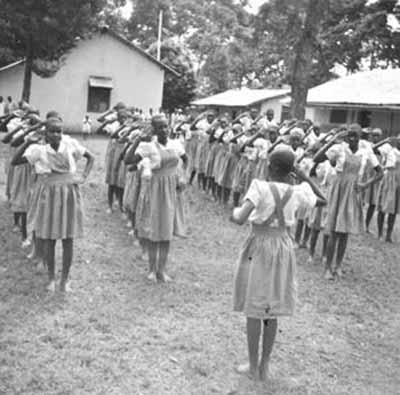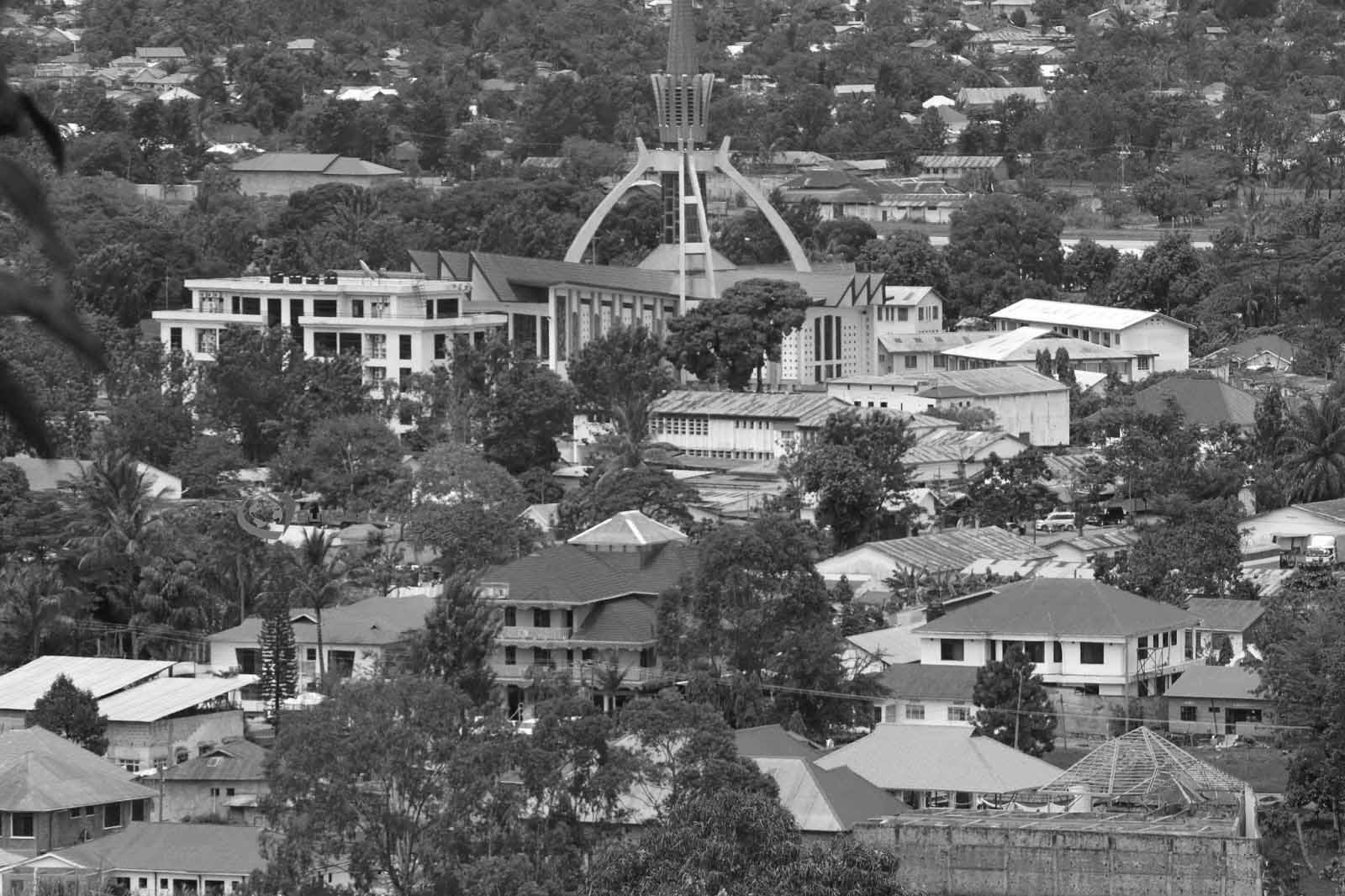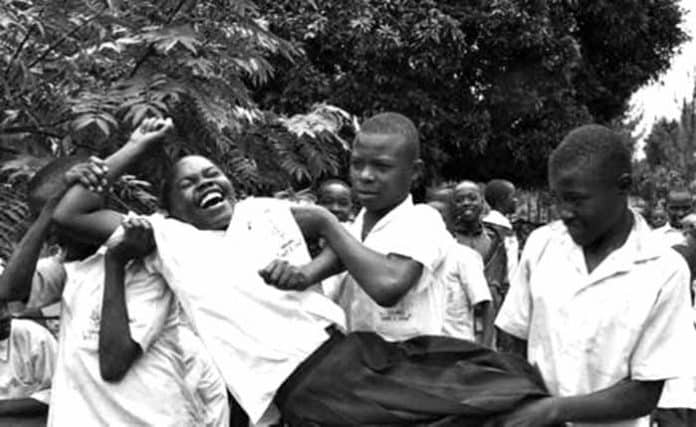The Tanganyika Laughter Epidemic of 1962 in the Bukoba District
An outbreak is defined as a disease that “spreads among people or communities at a particular time and is started by specific causes that are generally not present in the affected community“. As most common outbreaks of disease are caused by the spread of viruses, bacteria, or parasites, there is a tendency to forget that abnormal emotional behavior can spread from one person to another and thus take the form of an outbreak. It is the purpose of this information to report an outbreak in Bukoba district in northwestern Tanganyika, which was coined the name “Tanganyika laughter epidemic”. This outbreak was characterized by cases of laughter and crying. Not only it is exciting in terms of social education but how it disrupted the normal life of the community for six months, it is something of great importance to public health.

This laughter epidemic began on January 30, 1962 at a mission girls’ school run in Kashasha village, 25 miles from Bukoba. From that date until March 18, 1962, when the school was forced to close, 95 out of 159 students were affected. Fifty-seven students were affected from May 21, when the school reopened, until it was closed for the second time in late June. The spread of the disease in other areas is described below.
Kashasha School was a boarding school for girls between the ages of 12 and 18. Students sleep in dormitories where they were grouped by criteria of age. The disease did spread in an unusual way and did not involve many students in one boarding house at any one time. On January 30, three students began engaging in unusual activities, and the disease scattered rapidly in the school. None of the staff teaching at the school, including two whites and three Africans, were affected.
Clinical Perspective
Clinical researches and perspectives in general have been slightly different from one place to another, but they are basically the same. Most victims were girls and school boys who were in adolescent age, although adult men and women were involved. No educated and highly experienced community members were attacked.
The patient profile showed that he or she had often been in contact with someone who was suffering from the disease for some time. The period of maturation of the disease was seen to be from a few hours to a few days. The onset of the disease occurred suddenly, with laughter and crying attacks lasting for a few minutes to a few hours, followed by calming down and then starting again. Attacks were accompanied by instability and sometimes violence when one tries to control oneself. The patient often claimed that things are moving around in his head and that he is afraid that someone is chasing him. The study clearly showed the absence of abnormal physical signs. No fever was detected, although some reported having a fever after a few days. The only unusual conditions found were in the central nervous system. The students eye pupils were often widening without control, but all the time they showed reaction to light. Often the voluntary actions of the arteries holding the bones (tendons) in the legs unusually increased. There were no tremors or sudden convulsions or unconsciousness. The neck did not tighten.
The Source of the 1962 Tanganyika Laughter Epidemic
No serious cases were reported. Symptoms lasted from several hours in a few cases to a period of 16 days. During this time the patient is unable to fulfill his normal responsibilities and is difficult to control. Most of those affected have had more than one attack separated by a period of normal condition. The maximum number of attacks was four. No serious sequences were reported. However, school teachers said that for several weeks after their recovery, the girls were unable to attend school properly.
The Spread After the Outbreak
About 10 days after Kashasha school was closed for the first time and students were sent home, the disease broke out again at Nshamba village stadium, 55 miles west of Bukoba. Several of the sick girls from Kashasha came from this village. In April and May, 217 people out of a total of 10,000 people were attacked. Most of these were young adults of both sexes and the rest were school children. All the patients were cured and the disease had certainly disappeared in this area.
Ramashenye Girls’ Central School is located on the outskirts of Bukoba. Between the 10th and 18th June, when the school was forced to close, 48 girls out of 154 were attacked by the pandemic. Girls from Kashasha suffering from the disease were sent to their homes just few moment prior near Ramashenye school.
The next spread occurred in Kanyangereka village, 20 miles from Bukoba on June 18. A student from Ramashenye school had been sent home to the village on the 17th, as it was not possible to control him at school. An explosion in his village occurred in his immediate family, including his sister (16), brother (9) and mother-in-law (18). Her father’s sister-in-law who walked 10 miles to see the condition of the sick schoolgirl, within a few hours was also laughing and committing violence.
Some people in the village were soon affected and two boys’ schools 10 miles away were forced to shut down. There are no cases involving the head of the village, the police, school teachers, or people with similar educational backgrounds affected.
At the time of writing this article, the disease had spread to other villages, children’s education was severely disrupted and there was great fear among the village communities.
Analysis
Tests were performed to determine if the disease had a source of infection, poisoning, or psychological harm. Lumber injection for clinical sampling was performed in 17 cases and biochemical, bacterial, and microscopic examination showed no abnormalities. The study of the virus was conducted with the support of the Entebbe Uganda Virus Research Institute. Blood drawn from 15 active cases failed to grow and manifest the virus and no viral antibodies were obtained either in those who survived the disease or in people who were not infected.
An experiment was performed to find a common food cause that might have a toxic cell that could give a clinical picture. Water supply varied from rainwater collected in sealed tanks at Kashasha school to rural wells and canals in small villages. Kashasha School got its Matoke bananas, beans and meat from nearby villages, where no cases of the disease were reported. Maize flour for Kashasha and Ramashenye schools is purchased in Bukoba but made in the southern part of Lake Victoria. Bukoba Hospital and several schools that have not been affected by the disease are using the flour. The situation was the same with nuts. Samples of cornmeal and nuts were examined under a microscope to see if there was any presence of foreign seed contamination but no seed has been found to be contaminated.
Evidence was sought to obtain confirmation of the outbreak in the form of an epidemic. There is no record of an outbreak similar to this that occurred in this area before and hence there is no traditional name for this disease. The Haya, who make up the majority of the population,

call it “Enwara Yokusheka” (laughter disorder) or “Akajanja” a word that means madness. No meaningful information could be obtained from Kashasha school students who were previously affected, despite the fact that these tests were conducted by education officer who was also a Mhaya.
In the city of Bukoba, where the laughter epidemic created a huge fiasco, there was a belief that the atmosphere has been poisoned and as a result has been like an atomic bomb blast. Some believe that someone did put poison in the cornmeal. (Maize is not consumed at any rate by villagers, who eat the staple food “Matoke”. Many schools and hospitals, however, provide a basic meal of maize meal, as it is the cheapest among most other food)
Many patients said that they were afraid of something, but they did not give more information. They seemed to be afraid that someone was chasing them. There is a clear belief that this is an infectious condition of some kind. One villager described this belief as widespread madness.
The most severe outbreak and similar symptoms occurred near Mbarara, Uganda, about 100 miles north of Bukoba. It started in February and involved about 60 students in elementary school. The disease stopped there ever since.
How Did People React to the Tanganyika Laughter Epidemic?
Discussion
The mode of transmission of this disease appeared to be from one person to another. In many cases it was possible to diagnose the disease by following a recent infection with someone showing similar symptoms. This somehow indicated that the virus had spread through the infection via droplets. The results of laboratory tests, the lack of abnormal signals on physical examination and the fact that many patients had more than one attack of the disease are the opposite of the source of most infectious diseases.
Food contamination with toxic germs is a possible explanation. Datura Stramonium seeds contaminating wheat and maize flour have been implicated in food poisoning in East Africa before. This disease starts immediately after eating a meal made from flour contaminated with these seeds which was very similar to the Tanganyika laughter epidemic. However, dry mouth, dilated eyeballs and non-contact muscles found in datura poisoning were not seen in Bukoba. Also its symptoms lasted only a few hours as opposed to the average of seven days of the disease being discussed in this article. No dietary factor that was unique to the victims was found. No foreign seeds were found in the maize samples taken neither. The cause of the food poisoning could not explain the spread of the disease from one person to another.
The third possibility of mass hysteria was assumed to be the most likely explanation. We are in trouble for failing to explain why this disease started in the first place. Close questioning of the girls regarding their first attack of the Tanganyika laughter epidemic led nowhere. Once started, this massive outbreak could spread without any major cause.
The Middle Ages in Europe caused a number of mass hysteria outbreaks, of which the dancing mania in Germany and Italy is well-known. The outbreak followed the Black Death and is considered to be the result of the collapse of normal life caused by the plague.
Hecker (scientist) cites the following example of how compassion and imitation patterns grow under excitement: “In a cotton shop in Lancashire in 1787 a female worker put a rat on the neck of a colleague who was terrified of rats; the tremors she caused immediately continued with strong tremors for 24 hours. The next day three other women had tremors and by the fourth day at least 24 people had been affected; Among these was a male factory worker who was too tired to stop the women from insane hysteria so much that he himself contracted the disease. The disease did spread to neighboring factories because of fears over the theory that the disease was caused by a certain type of cotton poison. ”
In Tanganyika, in the village of Kanyangereka, where many families were attacked, a 52-year-old man living nearby saw the men during their attack. He was very angry at seeing their suffering, and as soon as he returned to his hut, where he lived alone, he felt something telling him to laugh and cry and scream. He continued to do so for most of that night.
The type of mental illness that affects the community is exacerbated by the culture of that community. Examples of this culture are Amok and Latah in Malaya, Koro in China and the Arctic hysteria in Siberia. Researchers describe a religious revival in Kentucky, USA, in the 1800’s when a number of people were so terrified of their future after death to such an extent which many began to show signs of jerky walking and falling to the ground in a state of unconsciousness. Some started barking like dogs, a condition that did spread from one person to another.
This Tanganyika laughter epidemic requires further research. In order to interpret this behavior as a natural or historical object of disease source, a cultural context study should be conducted. The Kentucky explosion followed a pattern similar to the emotional manifestation of the New England revival a few years earlier. We cannot find any written or oral records of Tanganyika laughter epidemic prior the one that happened in Bukoba district in the past.
Conclusion on the Laughter Epidemic Tanganyika Africa 1962
An outbreak of laughter, crying and restlessness (known as the Tanganyika laughter epidemic) in Bukoba district in Northern Tanganyika is described. The disease started in a girls’ school and went on to spread to other schools and villages in the area. No significant abnormal physical symptoms were found and all laboratory tests were normal. There are no causes for death. There was no apparent reason for the presence of toxins in the food supply. It was recommended that this be a major impediment among vulnerable people. Perhaps this was a disease that is culturally defined.
For more articles about health in Tanzania click here!


































